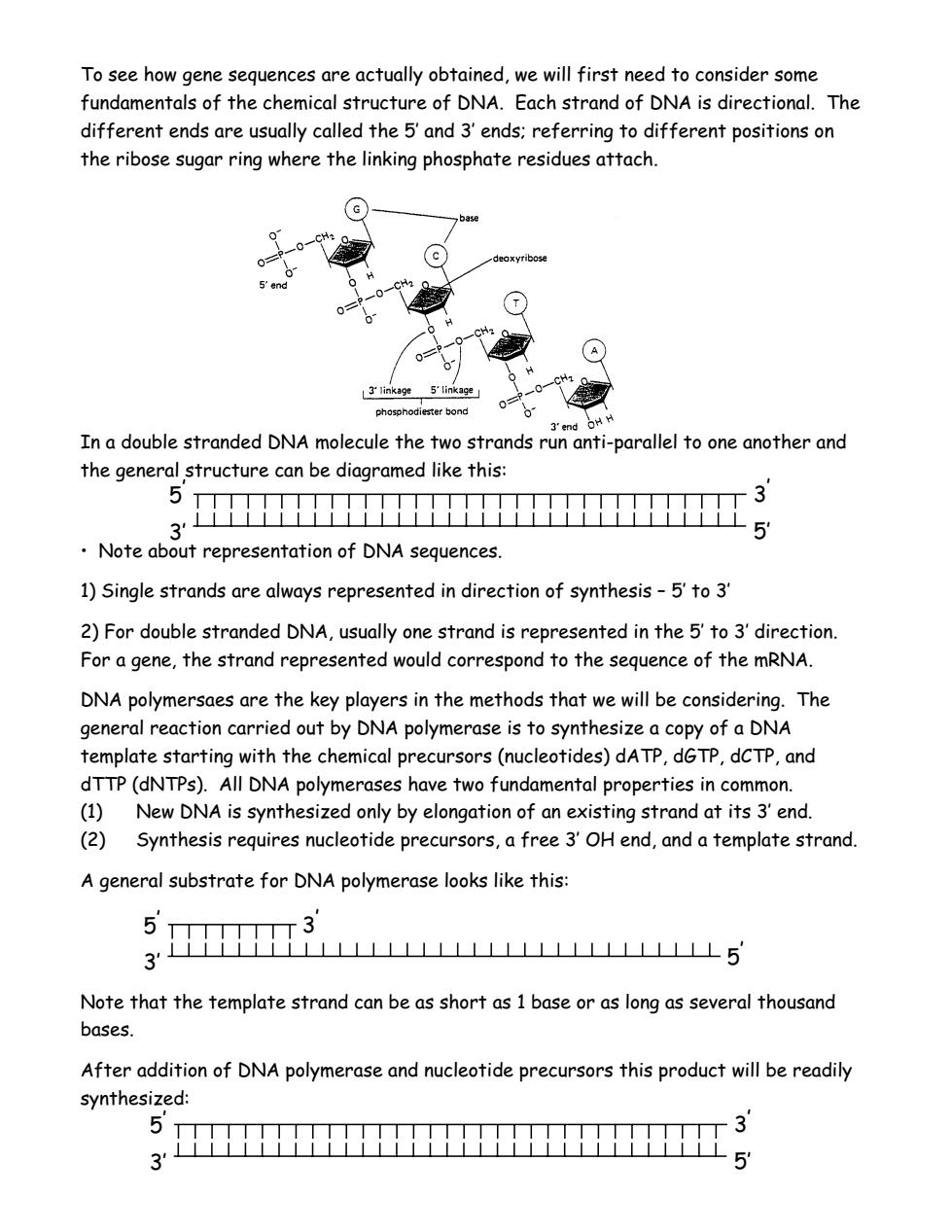正在加载图片...

To see how gene sequences are actually obtained,we will first need to consider some fundamentals of the chemical structure of DNA.Each strand of DNA is directional.The different ends are usually called the 5'and 3'ends;referring to different positions on the ribose sugar ring where the linking phosphate residues attach. deoxyribose L了1 linkage5'linka9e 0 phosphodiester bond 3'end OH H In a double stranded DNA molecule the two strands run anti-parallel to one another and the general structure can be diagramed like this: 5 3 3 51 Note about representation of DNA sequences. 1)Single strands are always represented in direction of synthesis-5'to 3 2)For double stranded DNA,usually one strand is represented in the 5'to 3'direction. For a gene,the strand represented would correspond to the sequence of the mRNA. DNA polymersaes are the key players in the methods that we will be considering.The general reaction carried out by DNA polymerase is to synthesize a copy of a DNA template starting with the chemical precursors(nucleotides)dATP,dGTP,dCTP,and dTTP(dNTPs).All DNA polymerases have two fundamental properties in common. (1)New DNA is synthesized only by elongation of an existing strand at its 3'end. (2) Synthesis requires nucleotide precursors,a free 3'OH end,and a template strand. A general substrate for DNA polymerase looks like this: 5 TTTTT3 3 LLL1111115 Note that the template strand can be as short as 1 base or as long as several thousand bases. After addition of DNA polymerase and nucleotide precursors this product will be readily synthesized: 5 3 3 5To see how gene sequences are actually obtained, we will first need to consider some fundamentals of the chemical structure of DNA. Each strand of DNA is directional. The different ends are usually called the 5’ and 3’ ends; referring to different positions on the ribose sugar ring where the linking phosphate residues attach. In a double stranded DNA molecule the two strands run anti-parallel to one another and the general structure can be diagramed like this: ’ ’ 5 3 3’ 5’ • Note about representation of DNA sequences. 1) Single strands are always represented in direction of synthesis – 5’ to 3’ 2) For double stranded DNA, usually one strand is represented in the 5’ to 3’ direction. For a gene, the strand represented would correspond to the sequence of the mRNA. DNA polymersaes are the key players in the methods that we will be considering. The general reaction carried out by DNA polymerase is to synthesize a copy of a DNA template starting with the chemical precursors (nucleotides) dATP, dGTP, dCTP, and dTTP (dNTPs). All DNA polymerases have two fundamental properties in common. (1) New DNA is synthesized only by elongation of an existing strand at its 3’ end. (2) Synthesis requires nucleotide precursors, a free 3’ OH end, and a template strand. A general substrate for DNA polymerase looks like this: ’ ’ 3 ’ 5 3’ 5 Note that the template strand can be as short as 1 base or as long as several thousand bases. After addition of DNA polymerase and nucleotide precursors this product will be readily synthesized: ’ ’ 5 3 3’ 5’